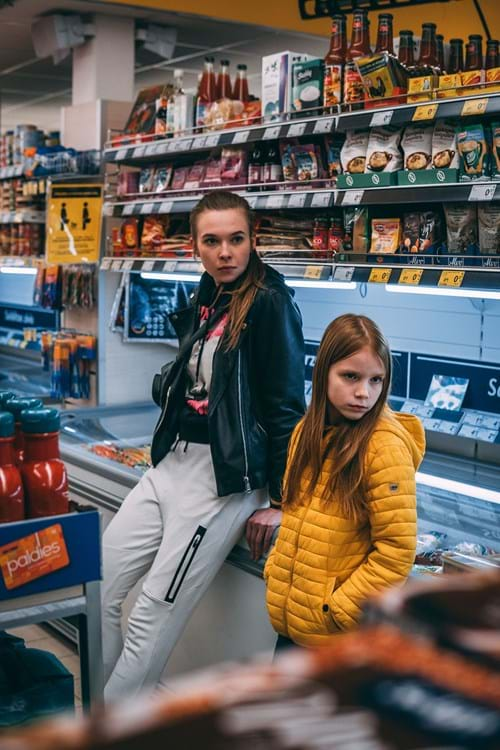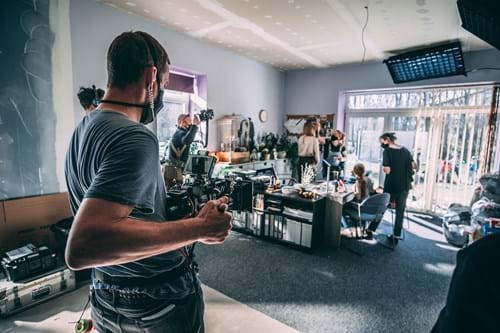With their mother in prison two young sisters, Anastasija and Diana, are living in an orphanage in Latvia. When an American family considers adopting both of them, they’re faced with a difficult decision. While Diana is immediately gung-ho about a life in the U.S., Anastasija is more hesitant, unconvinced that she even wants to be adopted at all. In the midst of their struggle to make a decision, Anastasija finds out that her birth mother has been released from prison some time ago – and all avenues seem reopened to the life for which she has always longed. But her mother has too many difficulties in her own life to be able to be there for Anastasija.
Sisters (Māsas) is director Linda Olte’s feature film debut, having previously worked primarily for Latvian television. Filming wrapped up in the first week of June, with a shoot in South Tyrol, most of which involved interiors. The film is a co-production between the Riga-based production companies Fenixfilm and Deep Sea Studios, and Bolzano-based Albolina Film.
The production history of Sisters begins with another project. Producer and director Matīss Kaža needed mountains for his Latvian western Wild East (earlier working title Where the Road Leads), and his cinematographer Aleksandrs Grebnevs knew the South Tyrolean mountain landscape from his university days. The production applied for funding from the South Tyrolean Film Fund (IDM) and Kaža hired Albolina Film, which offers production services in addition to its own productions, for the shoot in South Tyrol. The collaboration went swimmingly, and the idea for a joint project was born. Once again, Grebnevs was involved: in 2019, he introduced Matīss Kaža to director Linda Olte.
During the development process, the European infrastructure for film development proved its worth: the production won the Italian Baltic Development Award, established just three years ago and sponsored by MiC, Lithuanian Film Centre, Estonian Film Institute and the National Film Centre of Latvia. The award was announced last year at the When East Meets West co-production forum in Trieste. The screenplay, meanwhile, was partly developed during a workshop organized by the Sources 2 program. Last fall, the team submitted the project to the Warsaw co-production market for European children’s films called Kids Kino Industry. And funding for Sisters came from South Tyrol’s IDM, the Latvian National Film Center, Eurimages, and the Italian Tax Credit.
Italian-Latvian common ground
Principal photography first began on March 20, but a crew member tested positive for Covid right after the first day of shooting, shutting the production down. The shoot restarted on April 18 with some difficulties – crew agreements had to be readjusted because scheduled crew members had already been booked by other projects – but then sailed through the remaining 30 or so days without further incident. Both Wilfried Gufler of Albolina Film and Matīss Kaža emphasize the importance of having a mixture of basic trust and clear agreements between the partners during all of these co-production negotiations. The most important ground rule, Gufler says, was location: the Latvian team coordinated everything in Riga, while Albolina Film was responsible in South Tyrol.
Just how smoothly the project went is reflected in the fact that it was only minor details that caused any friction at all. Differing ideas about catering was one of them, and varying descriptions of departmental tasks, depending on the country of origin, was another. Kaža emphasizes that the real learning process with all these issues was that there is always a stark difference in film productions from one country to the next; you have to be aware of that, even if you think you’re working on the same set. For the most part, the solution was relatively simple.

Only one difference was really noticeable: the different customs and regulations between Italy and Latvia regarding working hours per day. While in Latvia 12 hours per day are common, the cap in Italy is 10 hours. However, in the end, this difference was simply factored into the shooting days and did not play any further role.
Defying the Pandemic
The biggest challenge facing the crew during this pandemic period was travel. When asked how Covid affected the shoot, Wilfried Gufler’s first response is that the pandemic made “everything more difficult and more expensive.” But he goes on to say that over the course of the emergency, they developed a way of dealing with the situation. The team was tested frequently and FFP2 masks were worn during filming to the extent possible. Gufler adds, that “It’s not so dramatic once people are shooting and stay in their microcosm; the travel phases are more of a problem.

Once the crew is housed together in a hotel, it’s easy to handle.” Matīss Kaža also recalls many discussions about crew travel and the constantly changing rules about who had to present which document where and when, or how recent Covid tests had to be. Finally, just when they thought they were through with the worst of it, another lockdown loomed shortly before the end of filming.
Despite all this, listening to the co-production partners talk now – during a break between shooting and post-production – the virus cannot have had much effect on the mood during the shoot. Wilfried Gufler raves about the “fresh, fantastic production,” Matīss Kaža is enthusiastic about the atmosphere on set and the respectful attitude toward producers and filmmakers in Italy. The latter are clearly seen “more as artists and not so much as part of an industry” there, he says. In retrospect, director Linda Olte is also impressed by how smoothly the shoot went. She says this has to do on the one hand with a certain pragmatism, which is due in no small part to the budget, and on the other hand with the well-rehearsed duo of cinematographers, Latvian Aleksandrs Grebnevs and South Tyrolean Harald Erschbaumer. For everyone, the diversity of languages on set was a source of great fascination. While the working language was English, many conversations took place in Latvian, Italian or Russian.
The break after the shoot is likely to be short-lived, especially for the director. Olte has often been responsible for editing her own work as well as directing it and intends to complete a rough cut by the end of August. Handing over “her baby” at that time will be new, but also the right thing to do, she adds during the interview. The co-production continues in the post-production phase: the composer and sound designer will both come from South Tyrol. The film should be ready for submission to 2022 festivals by the end of the year.
Producer Kaža notes that the pandemic has raised the hurdles in terms of release. The backlog of productions that could not be screened at festivals in the last 18 months because they were cancelled or could not be released in cinemas because they were closed, is noticeable to distributors and sales agents. As for Latvia, they already have a contract with a television station and there is definitely interest among distributors, so Kaža is confident that the film will find its way, in spite of the pandemic and the usual reluctance to release first films.
The Sisters production is an example of how co-productions between European countries that do not have a long tradition of such projects can run smoothly. Europe’s script-development infrastructure and film funding both play a part in this, as do the personal relationships that have been formed through training programs and professional contacts.